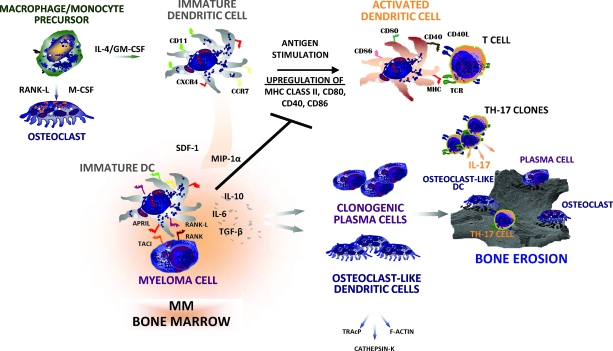Figure 1.
Pathophysiology of DC function within the myeloma marrow microenvironment. The fate of DCs is dependent on gradients of cytokines within MM bone marrow. They undergo functional maturation from macrophage/monocyte precursors under the influence of both IL-4 and GM-CSF. This enables a population of mature DCs to process and present antigens to T cells. However, it is conceivable that mature DCs may drive, within the tumor site, the expansion of a Th-17 clone leading to IL-17 overproduction that enhances osteoclastogenesis. On the other hand, DCs may undergo osteoclast-like transdifferentiation as an effect of the increased levels of both soluble and membrane-bound RANK-L produced by stromal cells, osteoblasts, and malignant plasma cells within the marrow microenvironment. This may result in the expansion of an immature subset of DCs that is recruited by malignant plasma cells and participates in bone resorption. Recruited immature DCs enhance the clonogenic growth of myeloma cells by cell-to-cell molecular contacts involving the TACI–APRIL pathway.
Abbreviations: APRIL, a proliferation-inducing ligand; CCR7, CC chemokine receptor 7; CXCR4, CXC chemokine receptor 4; DC, dendritic cell; IL, interleukin; MHC, major histocompatibility complex; MIP-1α, microphage inhibitory protein 1α; MM, multiple myeloma; RANK, receptor activator of nuclear factor κB; RANK-L, RANK ligand; SDF-1, stromal cell–derived factor 1; Th-17, T helper-17; TACI, transmembrane activator and calcium modulator and cyclophilin ligand interactor; TCR, T-cell receptor; TGF-β, transforming growth factor β; TRAcP, tartrate-resistant acid phosphatase.

